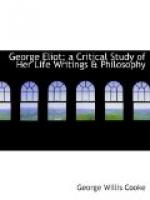In Romola it was first made clear that George Eliot is to be judged as a moralist as well as a literary artist. That she is a great literary artist, surpassed only by a select few, is to be borne constantly in mind; but as a moralist she surpasses most others in the amount of her teaching, and teaching which is thoroughly incorporated into the literary fibre of her work. She much resembles Wordsworth in this, that while she is an original creator of artistic forms and ideas, her books will be sought for their views of life as well for their qualities as novels. Wordsworth is a poet of vast original powers, but the poetic fire in him often burns low and his verses become mere prose. Yet his ideas about nature, life and morals command for him a place higher than that occupied by any other poet of his time, and a school of thinkers and critics has been developed through his influence. In much the same way, George Eliot is likely to attract attention because of her teachings; and it is probable her books will be resorted to and interpreted largely with reference to her moral and philosophical ideas. Should such a movement as this ever spring up, Romola will necessarily become one of the most important of all her books. Some of her principal ideas appear therein more distinctly, in clearer outline, and with a greater fulness of expression, than they obtain in any other of her books. The foreign setting of her story enabled her to give a larger utterance to her thoughts, while there was less of personal and pathetic interest to impede their expression. This is also true of The Spanish Gypsy, that it has more of teaching and less of merely literary attraction than any other of her longer poems. The purpose to do justice to the homely life of rustic England was no longer present, and she was free to give her intellectual powers a deliberate expression in the form of a thoughtful interpretation of a great historic period. Mr. Henry James, Jr., has recognized the importance of this effort, and says of Romola, that he regards it, “on the whole, as decidedly the most important of her works,—not the most entertaining nor the most readable, but the one in which the largest things are attempted and grasped. The figure of Savonarola, subordinate though it is, is a figure on a larger scale than any which George Eliot has elsewhere undertaken; and in the career of Tito Melema there is a fuller representation of the development of a character. Considerable as are our author’s qualities as an artist, and largely as they are displayed in Romola, the book is less a work of art than a work of morals. Like all of George Eliot’s works, its dramatic construction is feeble; the story drags and halts,—the setting is too large for the picture.”




